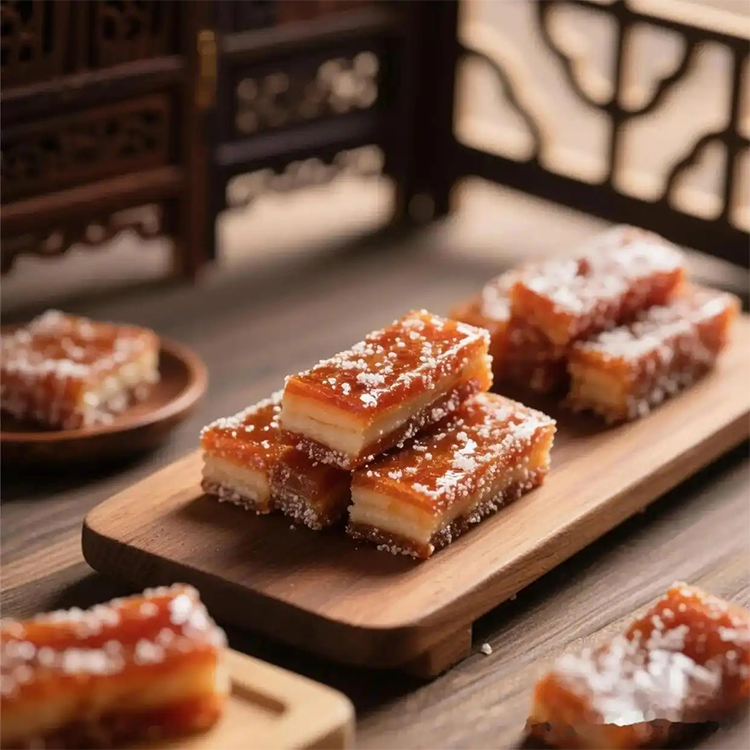Chinese Dessert Guide: Jinxiang Red Three-Cut Pastry and Its Sesame Heritage
1. History: From Qing Tribute to Local Treasure
In Jinxiang County, Jining City, Shandong Province, the Red Three-Cut pastry (Hong San Dao) is a traditional baked-and-fried snack dating back to the Qing dynasty. Legend says local officials once presented it as an imperial tribute for its distinctive shape and excellent flavor. Over three centuries it moved from palace tables to everyday homes, becoming a beloved Jinxiang specialty and a cultural symbol. The name “Red Three-Cut” refers to the three clear slashes on its surface—both a practical baking step and a sign of good luck.
2. Cultural Significance: Living Intangible Cultural Heritage
Recognized as a Shandong provincial intangible cultural heritage, the Red Three-Cut carries deep social meaning. It appears at Lunar New Year, Mid-Autumn Festival, weddings, and family gatherings as a gesture of sweetness, reunion, and blessing. For visitors, tasting Red Three-Cut is like sampling a living piece of local history and experiencing Jinxiang’s simple, warm folk traditions.

3. Key Ingredients: Simple, Carefully Selected Materials
The pastry’s unique flavor comes from a few quality ingredients: wheat flour, coarse sesame oil (da-cao), millet malt syrup (xiaomi yiyu), and white granulated sugar. Local wheat ensures a delicate crumb; toasted sesame oil gives the pastry its rich sesame aroma; and the mix of malt syrup and sugar produces the chewy-sweet center that contrasts with the crispy exterior.
4. Making Process: Traditional Handcrafted Technique
Traditional production is entirely handmade. Flour is mixed with sesame oil, malt syrup, and sugar into a soft dough, then rolled and scored with three shallow cuts on each piece. The cuts help even frying and create the signature look. Pastries are deep-fried at controlled temperatures until golden or deep red—timing is critical to achieve a crisp shell yet tender inside. Each batch depends on the baker’s experience, so every bite carries artisan skill.

5. Taste and Texture: Crispy Outside, Tender Inside
Red Three-Cut is visually tempting—golden to deep-red, with three crisply defined slashes. The shell cracks with a satisfying crunch while the interior stays soft and slightly chewy. The sweet malt and sugar balance with the toasted sesame aroma for a flavor that’s rich but not cloying. It pairs exceptionally well with a cup of unsweetened tea.
6. How to Eat and Serving Tips
Locals enjoy Red Three-Cut for breakfast, with tea, or as a festival snack. If buying prepackaged pieces, gently reheat in a low oven for a few minutes to restore crispness. Because it’s fairly sweet, eat in moderation—those with dietary restrictions (for example, diabetes) should be cautious. It also makes a thoughtful edible souvenir; buy from reputable shops to ensure authenticity.

7. Visitor Tips: Where and When to Try It
For the freshest experience, look for long-established pastry shops or market stalls in Jinxiang’s town center and traditional snack streets. Prices are affordable and often sold by the jin (half-kilo), making them easy to take home. Spring and autumn offer pleasant weather for combining food tasting with local events like temple fairs. Nearby attractions, such as Yangshan Ancient Town, can be paired for a cultural day trip.
8. Home Version: Simple Family Recipe
A simplified home recipe: combine 200g flour, 50g sesame oil, 100g millet malt syrup, 50g white sugar, and water to form a dough. Heat syrup, sugar, and sesame oil until combined, mix into flour, rest 30 minutes, roll out, and mark three cuts. Fry over medium heat until golden. Home-made versions won’t fully replicate artisan texture but are a fun way to taste Jinxiang at home.
Conclusion
Red Three-Cut is more than a pastry—it is a sweet carrier of Jinxiang’s history and culture. From its Qing dynasty origins as an imperial tribute to its status today as a provincial intangible cultural heritage, it invites travelers to taste 300 years of tradition. If you visit Shandong, don’t miss trying this sesame-scented treasure—one bite connects you to a living culinary legacy.


